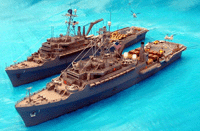In this latest addition to his acclaimed U.S. warship design history
series, Norman Friedman describes the ships and the craft of the U.S. amphibious
force, from its inception in the 1920s through World War II to the present.
He explains how and why the United States successfully created an entirely
new kind of fleet to fight and win such World War II battles as D-Day and
the island landings in the Pacific. To an extent not previously documented,
his book lays out the differing views and contributions of the U.S. Army,
Navy, and Marines as well as the British, and how they affected the development
of prewar and wartime amphibious forces.
|

|
Contents: Background for Modelers
Current and future amphibious forces and tactics are explained, together
with their implications for ships and craft, from 40,000-ton amphibious
carriers down to tracked amphibious vehicles.
For example, the arrival of atomic weapons hastened the use of helicopters to assault foreign shores. The basic WWII tactic of sending concentrated streams of crafts and men at the enemy, in hopes of overwhelming the defenses, would not survive even a limited nuclear strike. Forces would have to spread out for the trip in to shore, then quickly gather to focus the attack and overwhelm the defenses at close quarters, excluding the use of nukes. As this book explains, the answer was vertical assault. Helos could approach from a variety of directions (spreading out the Marines to limit the value of a nuclear strike against them), then quickly concentrate the Marines at a single point of attack.
As such changes in tactics developed, new classes of ships were needed to put the tactics into action.
| As in earlier volumes in the series, this study uses previously unpublished
sources to illustrate not only what was actually built but what was planned
and never brought into service. For example, the book offers the first
comprehensive and fully illustrated account of abortive attempts in the
1960s and beyond to build new fire support ships (LFS). |
 |
With nearly two hundred photographs and specially commissioned line
drawings and extensive appendixes, the work conveniently brings together
details of the ships and their service histories found elsewhere only in
scattered official references.
Specifically for the Ship Modeler
Available only in hardcover, and weighing in at 420 large, glossy pages,
this is serious stuff. For the modeler, there are multiple, clear B+W photos
of every craft, ship and vehicle that ever participated in an amphibious
assault starting around the time of WWI and running up through the San
Antonio class of proposed assault ships.
Most ships have line drawings of their basic layout, and to illustrate
their interior space allotment. Key vessels, such as the Tarawa and Wasp
class ships, have detailed side views, showing railing, antennas and the
like.
| The Newport class is shown in photos and with a model of one of the
ships with all the cables and rigging needed to open the bow and drop the
ramp. All of this is pure gold for a modeler interested in the 'Gator Navy.
About the only problem I can raise is that buying this book made me want
to go back and redo many of my amphibious ships based on this new (to me)
information. |
 |
A word about photos: I used to generally satisfied myself with photos
off the Internet when planning a build, and these in many cases are still
helpful. The good news is that if you are/were like me, working mostly
off the web for research, you can't believe what a difference a sharp photo
printed on glossy paper makes. Instead of smeary blobs on the foredeck,
you can see the details of the winch such that you can add it to your ship
or at the very least be informed what those raised bumps in smaller scales
actually represent.
Who is this Book For?
At US$59.50 and 420 pages, this book is not necessarily for every modeler.
However, if you have a specific interest in amphibious warfare or the ships
that make it happen, this book is your buddy for many a pleasant evening's
read. Particularly if you are interested in the history and tactics behind
amphibious ship design, you will enjoy this book.
As much as any ship, these vessels are designed as work horses, laid
out to satisfy the working demands of Sailors and Marines. These ships
often lack the sleek and graceful lines of their sisters, but when it comes
time to fight you desperately want them on your side.
 Follow this link to Amazon.com to buy U.S.
Amphibious Ships and Craft: An Illustrated Design History
Follow this link to Amazon.com to buy U.S.
Amphibious Ships and Craft: An Illustrated Design History
Can't find what you want? Try searching Amazon.com.

Questions about these reviews? Want to recommend a book
for review? Want to send us a book you publish for review? Email peter@modelwarships.com
All contents © Copyright 1999-2002 Peter Van Buren except as noted.
All rights reserved. Inclusion of links does not imply endorsement of contents.
All models are my own; click on any picture for an enlarged version. Shown
are JAG's 1/700 Austin and Raleigh and their Newport.

 Follow this link to Amazon.com to buy U.S.
Amphibious Ships and Craft: An Illustrated Design History
Follow this link to Amazon.com to buy U.S.
Amphibious Ships and Craft: An Illustrated Design History